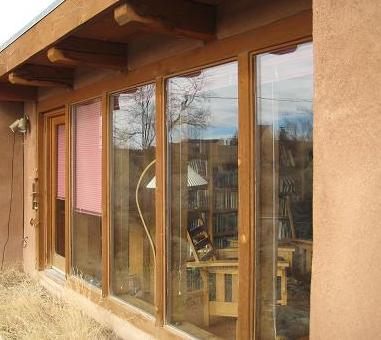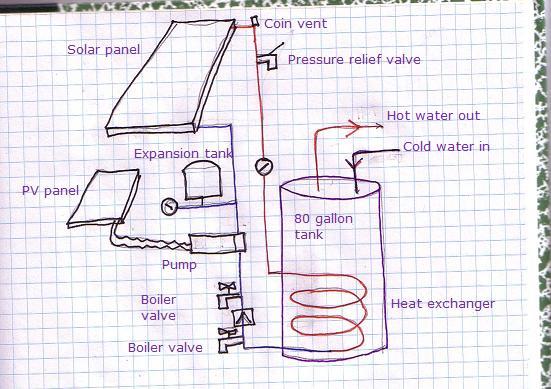Sagebrush Systems “world headquarters” is fortunate to be located in a building with passive solar heating. A large expanse of south-facing windows direct sunlight onto adobe walls and bare brick floors for heat storage.

The furnace hasn’t been turned on for over a decade, so we save a good deal on heating costs. (In full disclosure, the solar adobe construction of our building does not provide complete warmth at our latitude at 5000 feet elevation, but we throw on an extra sweater and become accustomed to somewhat lower temperatures than the 70 degree F office workers expect. For a couple of weeks each year we get consecutive days of overcast weather, requiring the fireplace to be used.)
We plan further energy independence, with solar hot water, possibly a supplemental solar hot air heater, and eventually a grid-tied photovoltaic system to supply all electricity needed by Sagebrush.
Our latest energy project was to install a solar hot water heating system. The area is blessed with plenty of solar exposure, averaging over 300 days of sunshine a year. A few periods in winter might have cloudy days extending for a solid week or two. We do have hard freezes, so a glycol system is necessary. (A drain-back system might work here, but based on the number of burst water lines we needed to fix in supposedly drained water lines running up to our evaporative cooler, we decided to use a glycol system.)
Active glycol systems can use an electronic controller to monitor temperatures and turn the circulating pump on and off, or use a pump connected to a photo-voltaic (PV) panel which runs the pump only when the sun shines. We wanted a PV system, based on the experience of a friend with a system installed a few decades ago, whose original manufacturer no longer exists and has difficulty getting the controller serviced. We also confess to a pyschological satisfaction of using no utility energy, even the minimal amount needed to run a circulating pump.
We wanted a kit-based system, so we could participate in installation and learn better how to maintain and use the equipment– and because it’s a challenge. Someday perhaps one could go to a big-box “home improvement” store and buy a solar hot water system in kit form or completely installed, but that day is not here, so we have to shop on the Internet. This system from SolarRoofs.com looks well-engineered for do-it-yourselfers, with a complete step-by-step installation manual and no soldering required. Their solar panels are also extremely light-weight, which should be an advantage for high slanted rooftop installations. Ultimately we decided against this system because of the plastic glazing: We get a LOT of UV radiation here, hard on plastics, and we recently replaced an acrylic sun roof that was thoroughly destroyed after twenty years of sun exposure. Perhaps these solar panel glazings have superior UV resistance, but how can a buyer prove that?

Ultimately we purchased a solar kit with tempered glass panel glazing, ordered from the venerable AAASolar, located in nearby Albuquerque. It doesn’t come with a complete install manual like the system above, but they did offer to provide reprints of articles from Home Power magazine dealing with installation. The article “DWHW Installation Basics Part 2” from June 2003 was particularly helpful. We also save on shipping charges, since they are so close, allow local pickup, and we have a truck available. The kit includes solar panel, storage tank, PV panel, pump, assorted valves and gauges. You supply plumbing available from your local hardware store. Propylene glycol and pipe insulation are extra.
In future posts we document our adventures (and minor missteps) in installing the system:
Solar 2: Installing the panel.
Solar 3: Connecting everything.
Solar 4: Starting up and running, lesson, and future.
Related Posts: Power to the Programmers